Discovering the best home gardening practices for lush greens involves various techniques and tips. Organic home gardening techniques are the way to go! There are many benefits of implementing these practices, including cost-effectiveness and the overall satisfaction of growing your own food. Let’s take a look at some of the best home gardening techniques for achieving a thriving garden.
Key Takeaways:
- Starting a garden with seeds is affordable and fun.
- Mulching helps to minimize weeding time and improves soil health.
- Planting fragrant flowers and herbs adds a delightful dimension to the gardening experience.
- Growing herbs in containers is an excellent option for those with limited space.
- Add tropical foliage plants to bring a lush feeling to outdoor spaces.
- Regularly surveying the garden helps to identify and address any pest or disease issues.
- Planting native perennials that are adapted to the local climate requires less care.
- Trellises and vines can provide privacy and cover unattractive areas.
- Replacing struggling areas of turf with perennial groundcovers reduces the need for mowing.
- Harvesting edibles from the landscape adds beauty and functionality to the garden.
Start Your Garden with Seeds for a Thrilling Gardening Experience
Sowing seeds is an inexpensive and thrilling way to involve kids in gardening. It’s amazing to see tiny seeds germinate and grow into seedlings in just a matter of days. All you need is some potting soil, a vessel or the ground, water, and seeds to get started.
If you’re looking to create a lush and beautiful garden, consider adding fragrant flowers and herbs. Planting flowers and herbs that emit a sweet perfume can enhance the overall gardening experience. Some fragrant perennial flowers to consider are roses, peonies, and lilacs. Annuals like heliotrope, petunia, and alyssum also add pleasant scents. Additionally, growing herbs in a container on a patio can provide a variety of flavors for your cooking.
For an exotic touch, consider incorporating tropical foliage plants into your garden. Palms, Dracaena, and Sansevieria are great choices that can create a tropical ambiance on porches or patios. These plants can be enjoyed throughout the summer and then brought indoors for every room, also helping to purify the indoor air.
Regularly walking through your garden for just a few minutes each day can help you spot any potential issues like insect pests or diseases before they become major problems. It’s also a good opportunity to deadhead faded blooms to encourage more flowers to grow.
Consider planting native perennials in your garden. These plants are adapted to the specific climate, rainfall, and soil conditions of your region, making them easier to care for compared to other perennials.
If you’re looking for privacy or to cover up unsightly areas, consider using trellises and growing fast-growing annual or perennial vines. Morning glory, sweet peas, and clematis are great options for creating beautiful screens or covers.
For areas in your garden where the grass is struggling, replace it with perennial groundcovers like Ajuga, Vinca, and Pachysandra. These groundcovers require less maintenance than turf grass and can add lushness to shaded spots or areas with shallow tree roots.
Lastly, consider incorporating edible plants into your landscape. The joy of stepping out and harvesting fresh fruits, vegetables, and herbs from your own garden is a rewarding experience. Blueberries, strawberries, and basil are just a few examples of edible plants that can be grown in small spaces or containers.
Cultivating a beautiful and bountiful garden can be an exciting and fulfilling experience. Starting with seeds is a great way to get started, and incorporating these tips can help you create an outdoor space that you can enjoy for years to come.
Mulching to Minimize Weeding and Enhance Soil Health
Adding a thick layer of mulch around garden plants and trees helps minimize weeding time and effort, making it easier to maintain a lush and healthy garden.
There are many types of mulch that can be used in home gardening, including shredded cedar bark, pine needles, grass clippings, gravel, and stone. Mulch made from plant material will break down over time and can be refreshed with a top layer every few years.
In addition to weed control, mulching also improves soil health by retaining moisture, regulating temperature, and reducing erosion. This allows for healthier plant growth and reduces the need for excessive watering.
Mulching is a simple and effective technique for maintaining a weed-free garden and promoting soil health. By incorporating this technique into your home gardening ideas, you can enjoy a bountiful and beautiful landscape.
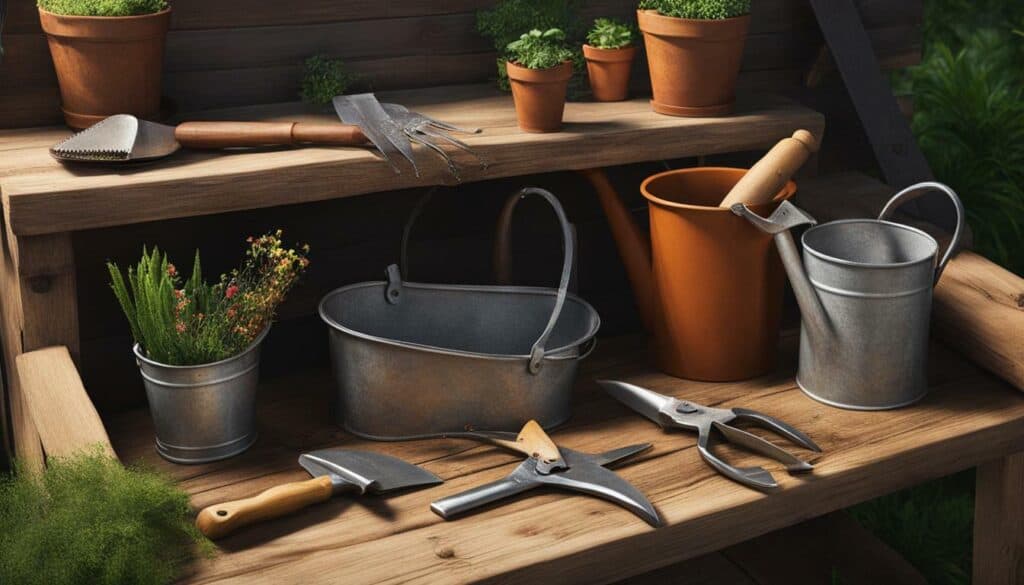
Enhance Your Garden with Fragrant Flowers and Herbs
Enhance your gardening experience by including fragrant flowers and herbs in your garden. Planting fragrant flowers like roses, peonies, and lilacs can provide sweet perfume while adding color to your garden. Annuals such as heliotrope, petunias, and alyssum can be planted in containers to create scents. Growing a herb garden in a container is also a great option for those with limited space. Herbs like basil, thyme, oregano, cilantro, and rosemary not only add flavor to your cooking but also release delightful aromas.
Adding tropical foliage plants like palms and dracaena can bring an exotic touch to your garden. It’s important to regularly maintain your garden by removing faded blooms, monitoring for pests and diseases, and using mulch to reduce weeding time. Consider planting native perennials as they require less care and can thrive in your region’s climate and soil. Vines can be used to create privacy or cover unsightly areas, while groundcovers like Ajuga and Vinca are great for shaded spots.
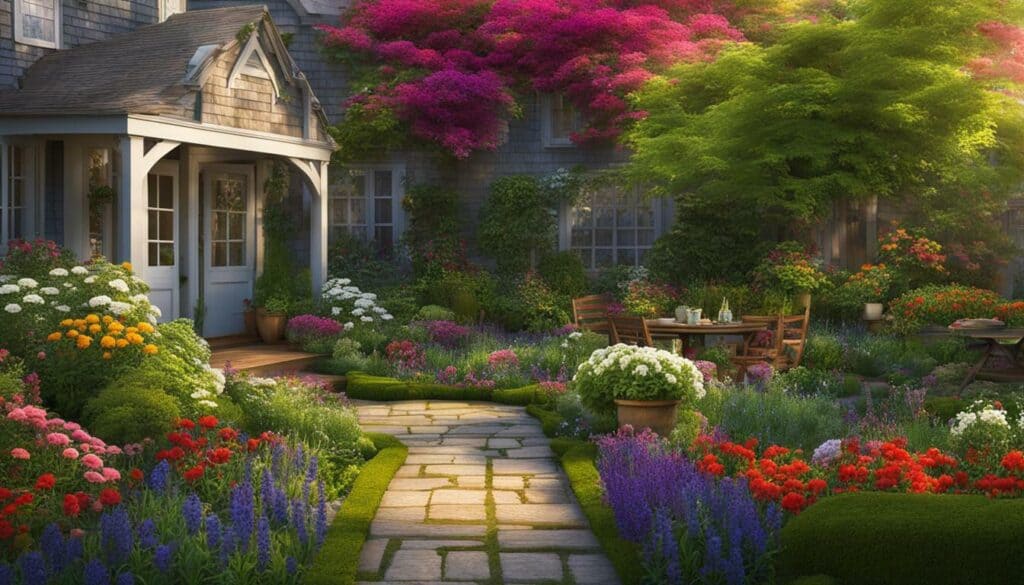
Last but not least, consider incorporating edible plants into your landscape, such as blueberries, strawberries, and basil, so you can enjoy the fruits and flavors of your garden. Whether you have a small balcony or a vast backyard, there are numerous home gardening ideas that you can use to create a lush and beautiful garden. Indoor home gardening is also a great way to grow plants year-round, even if you don’t have outdoor space.
Cultivate a Lush Herb Garden in Containers
Even if you don’t have space for a vegetable garden, you can cultivate a lush herb garden in a container. It’s a great way to have fresh herbs at your fingertips and add a touch of greenery to your balcony or patio. Plus, it’s easy to do! Start by selecting a variety of herbs that reflect your cooking tastes. For Mediterranean flavors, choose basil, thyme, and oregano. For Asian dishes, consider cilantro, lemon grass, and Thai basil.
Plant your herbs in containers with enough space for their roots to grow. Use potting soil and ensure proper drainage by adding pebbles or stones at the bottom of the pot. Water your container garden regularly to keep the soil moist. You can also add some organic fertilizers to keep your herbs healthy and thriving.
Aside from herbs, you can also add fragrant flowers to your container garden for an extra burst of color and aroma. Consider planting lavender, roses, or lilies to enhance the gardening experience. Walk through your garden daily to check for any pests or diseases and remove faded blooms to encourage more flowers to grow.
If you want to add a touch of the tropics to your container garden, bring in leafy, tropical foliage plants like palms and Dracaena. These plants are perfect for enhancing your garden’s aesthetic appeal and giving it that lush, tropical feel.
With these home gardening techniques and hacks, your container herb garden can be a beautiful and thriving addition to your home. So go ahead and start cultivating today!
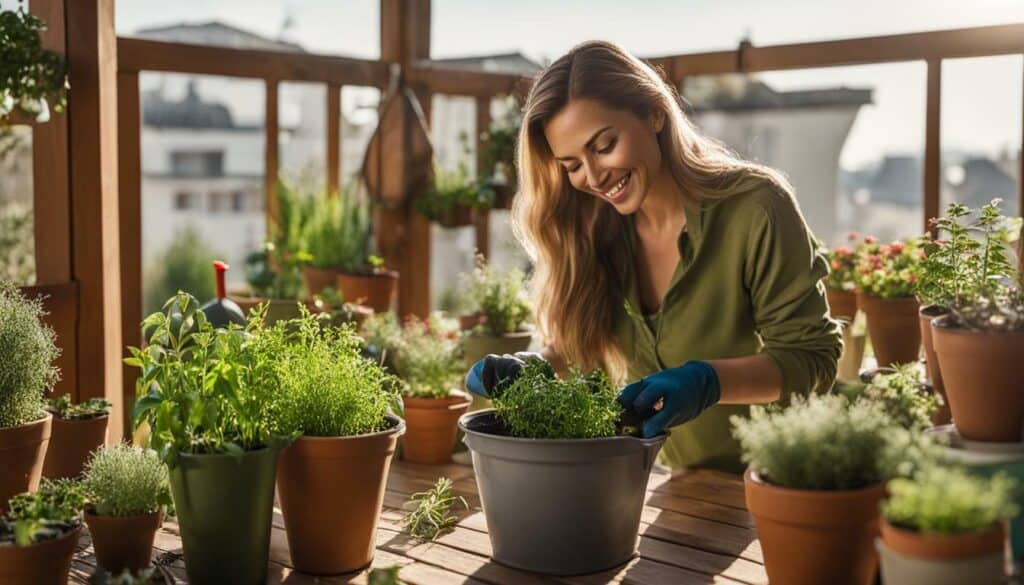
Bring a Touch of the Tropics to Your Garden
Bring a touch of the tropics to your porch or patio with leafy, tropical foliage plants. But don’t stop there – you can also incorporate a lush and vibrant atmosphere into your garden with a few simple techniques.
Start by sowing tropical plant seeds like hibiscus or bird of paradise to add a pop of color and unique texture to your garden. Keep in mind that some tropical plants may require specific growing conditions like high humidity or well-draining soil, so do your research before planting.
Mulching your garden with materials like shredded cedar bark or pine needles not only enhances soil health, but it also reduces weeding time, allowing you to spend more time enjoying your garden. Additionally, planting fragrant flowers and herbs like lavender or rosemary can create a multi-sensory experience for you and your guests.
To add a lush feel to your garden, consider growing tropical foliage plants like palms or sansevieria in containers or directly in the ground. These plants not only provide an exotic touch, but they are also easy to care for, making them perfect for indoor home gardening as well.
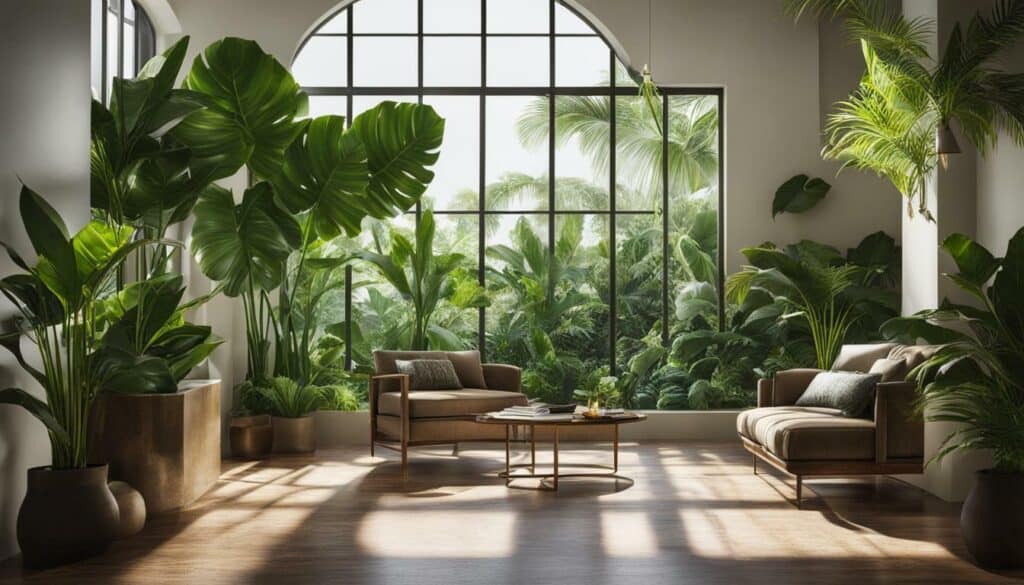
To maintain a healthy garden, it is important to survey your garden daily for pests and deadhead faded blooms regularly. Consider using native perennials that are adapted to your climate and require less care, or utilize flowering vines or trellises to create privacy or cover unsightly areas. Replace struggling turf with perennial groundcovers for easier maintenance and harvest edible plants like blueberries and strawberries from your landscape.
Keep your lawn trim and mow it regularly, paying attention to cutting height. Feed your lawn with a slow-release fertilizer if necessary, and protect it from insects and weeds by using eco-friendly sprays or hand-pulling. Treat fungal attacks with fungicide as soon as possible to prevent spreading.
Create a dense and lush garden by planting plants close together to maximize space and reduce weed growth. Prune shrubs and hedges regularly to give your garden shape and focus on nourishing the soil with compost to promote healthy roots. Finally, plant a variety of greenery and colorful flowers to add texture and visual interest to your garden.
Regular Garden Surveillance for Pest and Disease Control
Take a few minutes each day to walk through your garden to check for insect pests or diseases. Regular garden surveillance is essential for effective pest and disease control. By monitoring your garden regularly, you can identify insect pests or signs of disease early on and take appropriate action. This can help minimize the damage caused by pests and prevent diseases from spreading.
It is also important to remove faded blooms regularly to encourage plants to produce more flowers. Deadheading is a technique where you remove the spent flowers from a plant. This helps the plant redirect its energy toward producing new blooms.
Native perennials are a great option for a low-maintenance garden. They are already adapted to the climate and soil conditions in your area, so they require less care. Additionally, using trellises with flowering vines like morning glory or perennial varieties like clematis is an effective way to add both privacy and aesthetic appeal to your garden.
Another way to minimize maintenance is by removing struggling areas of turf and replacing them with perennial groundcovers. This can help create a lush landscape while minimizing the need for frequent mowing and maintenance.
Finally, incorporating edible plants into your garden is a great way to have easy access to fresh fruits, vegetables, and herbs. However, it is important to maintain a proper cutting height when mowing your lawn, as taller grass encourages deeper roots and healthier growth. Feeding your lawn with compost and paying attention to pests like cutworms and webworms are also important for maintaining a healthy green lawn.
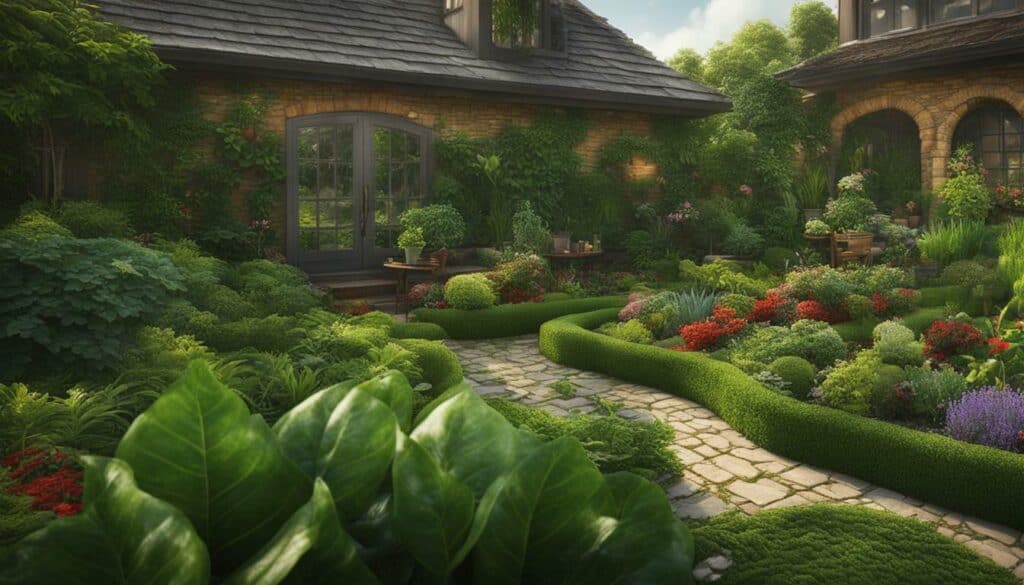
Gardening Tips and Tricks for Sustainable Home Gardening
- Walk through your garden regularly to check for insect pests or diseases.
- Remove faded blooms regularly to encourage plants to produce more flowers.
- Use native perennials to minimize maintenance.
- Use trellises with flowering vines for privacy and aesthetic appeal.
- Remove struggling areas of turf and replace them with perennial groundcovers.
- Incorporate edible plants to have easy access to fresh fruits, vegetables, and herbs.
- Maintain a proper cutting height when mowing your lawn to encourage deeper roots and healthier growth.
- Feed your lawn with compost and pay attention to pests like cutworms and webworms for a healthy, green lawn.
By following these tips and regularly monitoring your garden, you can ensure effective pest and disease control while enjoying a beautiful and thriving outdoor space.
Harness the Benefits of Native Perennials in Your Garden
Native perennials are well-adapted to the climate, rainfall, and soil in your region, requiring less care than other perennials. By using native species, you can reduce the need for excessive watering, fertilizing, and pest control measures in your garden. Apart from being low-maintenance plants, native perennials have evolved to be better suited to your region than other non-native plants, which means they often perform better.
Incorporating native perennials into your garden may also attract local wildlife, including birds, butterflies, and bees, promoting biodiversity in the area. Additionally, these plants have deep roots that help stabilize the soil, prevent erosion, and improve water infiltration.
Using native perennials in your garden can contribute to preserving the local ecosystem and supporting the conservation of native plant species. You can enhance your garden’s beauty, sustainability, and ecological value by choosing plants that are native to your region.
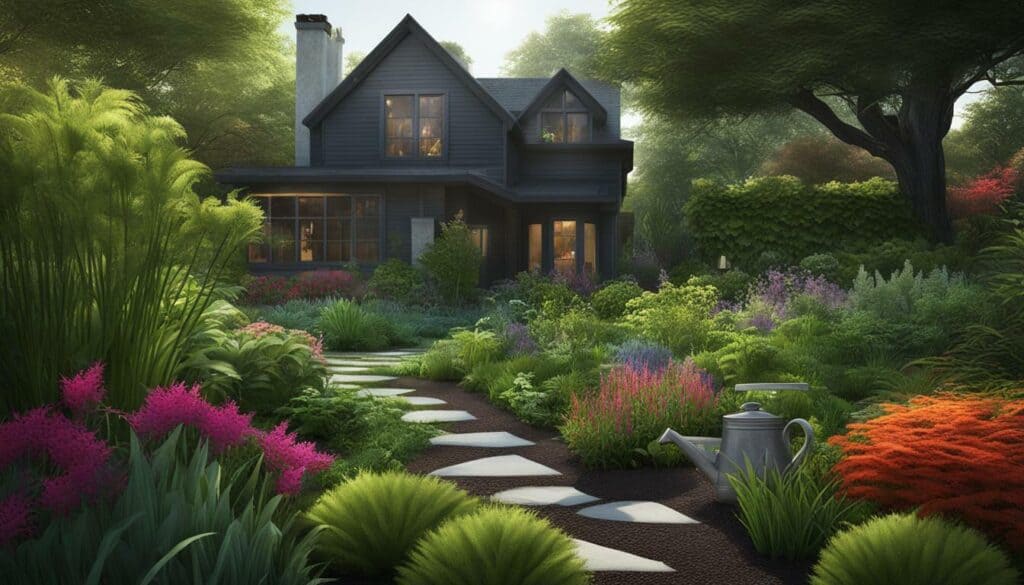
In conclusion, incorporating native perennials in your garden is a sustainable home gardening technique that offers numerous advantages. These plants are well adapted to your region, require less care, attract local wildlife, stabilize the soil, and promote biodiversity. By choosing native plant species, you can contribute to preserving the local ecosystem, supporting conservation efforts, and enhancing the beauty and ecological value of your garden.
Utilize Flowering Vines for Privacy and Aesthetic Appeal
Use flowering vines like morning glory, sweet peas, or honeysuckle to create privacy or cover unsightly fences or walls. Flowering vines can serve multiple purposes in your garden, providing both privacy and aesthetic appeal. They can be grown on trellises to create beautiful screens or cover-ups, making them a great solution for unsightly fences or blank walls.
| Vine Varieties | Description |
|---|---|
| Morning Glory | A fast-growing annual vine that produces bright, trumpet-shaped flowers in a variety of colors. |
| Sweet Pea | A fragrant annual vine that produces clusters of delicate flowers in shades of pink, purple, and white. |
| Clematis | A perennial vine that produces large, showy flowers in shades of purple, pink, and white. |
| Honeysuckle Vine | A fast-growing perennial vine that produces clusters of fragrant flowers in shades of yellow, pink, and white. |
| Trumpet Creeper Vine | A vigorous perennial vine that produces exotic, trumpet-shaped flowers in shades of red or orange. |
These vines not only add visual interest but can also emit a pleasant fragrance, such as jasmine, which can enhance the ambiance of your porch or patio. By incorporating these flowering vines into your garden, you can create a private and visually appealing outdoor space.

Incorporate Groundcovers for Easy Maintenance and Enhanced Landscape
Replace struggling turf areas with perennial groundcovers like Ajuga, Vinca, or Pachysandra to reduce mowing and enhance the landscape. These low-growing plants are well-suited to the climate and soil conditions in your region, making them an ideal choice for a low-maintenance garden. By incorporating groundcovers, you can eliminate the need for frequent mowing and maintenance, while also adding texture and color to your landscape.
| Plant | Description | Care |
|---|---|---|
| Ajuga | Also known as Bugleweed, this groundcover features glossy, green leaves and spikes of blue or pink flowers in spring. It can thrive in shade to full sun and requires moderate moisture. | Keep the soil moist and trim back any overgrown areas. |
| Vinca | Also known as Periwinkle, this groundcover produces blue, purple, or white flowers in spring and summer. It prefers partial shade and well-draining soil. | Water regularly and prune back in late summer to control growth. |
| Pachysandra | Also known as Japanese Spurge, this groundcover features glossy, green leaves and fragrant white flowers in spring. It thrives in partial to full shade and moist, well-draining soil. | Keep the soil moist and prune back any overgrown areas. |
By planting groundcovers in your garden, you can enjoy a beautiful and low-maintenance landscape. Groundcovers help to reduce the need for frequent mowing and maintenance, while also adding texture and color to your garden. Choose a low-care option like Ajuga, Vinca, or Pachysandra and enjoy a beautiful and thriving garden.

Conclusion: Achieve a Beautiful and Bountiful Landscape with the Best Home Gardening Practices
Incorporating the best home gardening practices, such as starting seeds, mulching, and utilizing native plants, can help you achieve a beautiful and bountiful landscape. Starting your garden with seeds is an affordable and exciting way to involve kids in gardening and witness the germination process. Mulching around your plants can minimize weeding time, and certain materials like shredded cedar bark or pine needles can provide extra benefits as they decompose.
Adding fragrant flowers and herbs can enhance your gardening experience with sweet perfumes and beautiful blooms. Perennials like roses, peonies, and lilacs are great options, while heliotrope, petunia, and alyssum are scented annuals to consider. Container gardening is a great option for those with limited space, and herbs like basil can provide flavors for cooking.
Tropical foliage plants can bring a lush feel to your porch or patio, creating a jungle ambiance. They can be enjoyed outdoors in the summer and brought inside during colder months. Regular garden surveillance allows you to identify and treat any pest or disease issues early, and removing faded blooms can encourage more flower production.
Choose native perennials for a more sustainable garden, as they are already adapted to the local climate, rainfall, and soils, reducing the need for care and maintenance. Vines like morning glory, sweet peas, and Clematis can serve as excellent screens or cover-ups for privacy or unsightly areas.
Perennial groundcovers can replace struggling turf and add a lush selection of plants to your landscape. Finally, incorporating edible plants into your front or backyard can provide fresh fruits, veggies, and herbs right outside your door. Blueberries, strawberries, and basil are just a few examples of edibles that can be grown in small spaces.
By following these best home gardening practices, you can create a stunning outdoor space to relax and enjoy. Proper maintenance, trimming, nourishing the soil, creating wide beds, and adding diversity with flowers and foliage will help you achieve a beautiful and bountiful landscape.
What are some tips for achieving a lush garden at home?
Creating a joyful home gardening experience begins by choosing the right plants for your specific climate and soil conditions. Ensure proper soil preparation, watering techniques, and regular maintenance, including pruning and fertilizing. Additionally, prioritize planting in well-drained areas with ample sunlight. Consistency and patience are key to achieving a lush garden that brings immense satisfaction to your home.
FAQ
Q: What are the best home gardening practices for lush greens?
A: Some of the best home gardening practices for lush greens include starting seeds, mulching, planting fragrant flowers and herbs, growing herbs in containers, adding tropical plants, regularly surveying your garden, planting native perennials, using flowering vines, incorporating groundcovers, and harvesting edibles from your landscape.
Q: How do I start a garden with seeds?
A: Starting a garden with seeds is a thrilling and cost-effective way to grow plants. All you need is potting soil, water, and seeds. Simply sow the seeds in the soil and provide them with proper care and attention.
Q: What is mulching and why is it important?
A: Mulching involves adding a layer of material around garden plants and trees. It helps minimize weeding time, improve soil health, and conserve moisture. Materials like shredded cedar bark, pine needles, or grass clippings can be used as mulch.
Q: How can I enhance my garden with fragrant flowers and herbs?
A: You can enhance your garden by including fragrant flowers and herbs. Perennial flowers like roses, peonies, and lilacs are known for their fragrance. Herbs like basil, thyme, cilantro, and rosemary also provide flavorful leaves and flowers.
Q: Can I grow herbs if I don’t have space for a vegetable garden?
A: Yes, you can still cultivate a lush herb garden in containers, even if you don’t have space for a vegetable garden. Herbs like basil, thyme, cilantro, and rosemary are easy to grow in containers and can provide fresh flavors for your meals.
Q: How can I bring a touch of the tropics to my garden?
A: You can bring a touch of the tropics to your garden by adding leafy, tropical foliage plants like palms, Dracaena, and Sansevieria. These plants can be enjoyed outdoors in the summer and indoors during colder months.
Q: Why is regular garden surveillance important?
A: Regularly surveying your garden allows you to check for insect pests or diseases. By detecting these issues early on, you can take necessary measures to prevent further damage and maintain a healthy garden.
Q: What are the benefits of planting native perennials?
A: Native perennials are well-adapted to the local climate, rainfall, and soil conditions in your region. As a result, they require less care and are more sustainable. Planting native perennials helps support local ecosystems and biodiversity.
Q: How can I use flowering vines in my garden?
A: Flowering vines like morning glory, sweet peas, or honeysuckle can be used to create privacy or cover unsightly fences or walls. These vines add beauty and variety to your garden, with their colorful blooms and trailing foliage.
Q: What are the benefits of using groundcovers in my garden?
A: Using perennial groundcovers like Ajuga, Vinca, or Pachysandra can solve lawn problems and reduce the need for frequent mowing. These groundcovers also enhance the overall landscape by providing greenery, reducing soil erosion, and suppressing weed growth.
Q: Can I harvest edibles from my landscape?
A: Yes, you can incorporate a variety of beautiful edible plants into your landscape. Blueberries, strawberries, and basil are examples of edible plants that can be grown in your garden, providing fresh produce for you to enjoy.
Source Links
- https://crescospreaders.com/achieve-lush-green-lawn/
- https://www.bhg.com/gardening/yard/garden-care/our-top-10-garden-tips/
- https://www.homestolove.com.au/how-to-make-your-garden-lush-3147
- https://www.growingagreenerworld.com/tips-for-growing-the-perfect-vegetable-garden/
- https://www.epicgardening.com/
- https://balconygardenweb.com/make-your-home-a-lush-green-oasis/
- https://www.jacksonville.com/story/lifestyle/home-garden/how-to/2021/01/30/gardening-experience-fun-starting-your-plants-seeds/4277444001/
- https://www.creativevegetablegardener.com/reasons-to-start-seeds-indoors/
- https://simpleecomama.com/my-gardening-journey-seed-starting-indoors-101/
- https://www.canr.msu.edu/news/smart_gardeners_improve_their_soil_and_weed_control_with_organic_mulch
- https://hgic.clemson.edu/factsheet/controlling-weeds-by-cultivating-mulching/
- https://www.thespruce.com/mulch-for-weed-control-soil-health-2539779
- https://www.loveyourlandscape.org/expert-advice/shrubs-and-flowers/plant-selection/enhance-any-garden-with-herbs/
- https://www.homesandgardens.com/advice/aromatic-herbs
- https://www.homesandgardens.com/news/how-to-plant-a-fragrant-garden-220181
- https://savvygardening.com/best-herbs-for-container-gardening/
- https://www.foodandwine.com/how-to-grow-herbs-7499957
- https://www.homesandgardens.com/gardens/growing-herbs-in-pots
- https://www.chestnuthilllocal.com/stories/garden-design-trend-brings-a-touch-of-the-tropics,28660
- https://storables.com/garden/storage/tropical-garden-ideas-10-tips-to-turn-your-garden-into-an-oasis/
- https://www.dreamzar.app/post/20-tropical-garden-design-ideas-for-a-vacation-vibe-at-home
- https://njaes.rutgers.edu/fs1123/
- https://www.canr.msu.edu/resources/ipm_smart_pest_management_for_the_vegetable_garden
- https://www.thespruce.com/garden-pest-control-1402737
- https://www.fs.usda.gov/wildflowers/Native_Plant_Materials/Native_Gardening/index.shtml
- https://www.asla.org/nativeplantssavemoney.aspx
- https://www.epicgardening.com/native-plant-benefits/
- https://gardenandhappy.com/flowering-vines/
- https://www.realsimple.com/home-organizing/gardening/outdoor/flowering-vines
- https://www.veranda.com/outdoor-garden/g32115602/flowering-vines/
- https://www.finegardening.com/article/pull-a-design-together-with-ground-covers
- https://www.southernliving.com/garden/plants/ground-cover-plants-flowers
- https://www.bhg.com/gardening/flowers/perennials/easy-ground-covers/
- https://www.ncbi.nlm.nih.gov/pmc/articles/PMC6600618/
- http://menu.ci.cerritos.ca.us/research/booklists/gardening.html
- https://foyr.com/learn/best-home-garden-ideas/

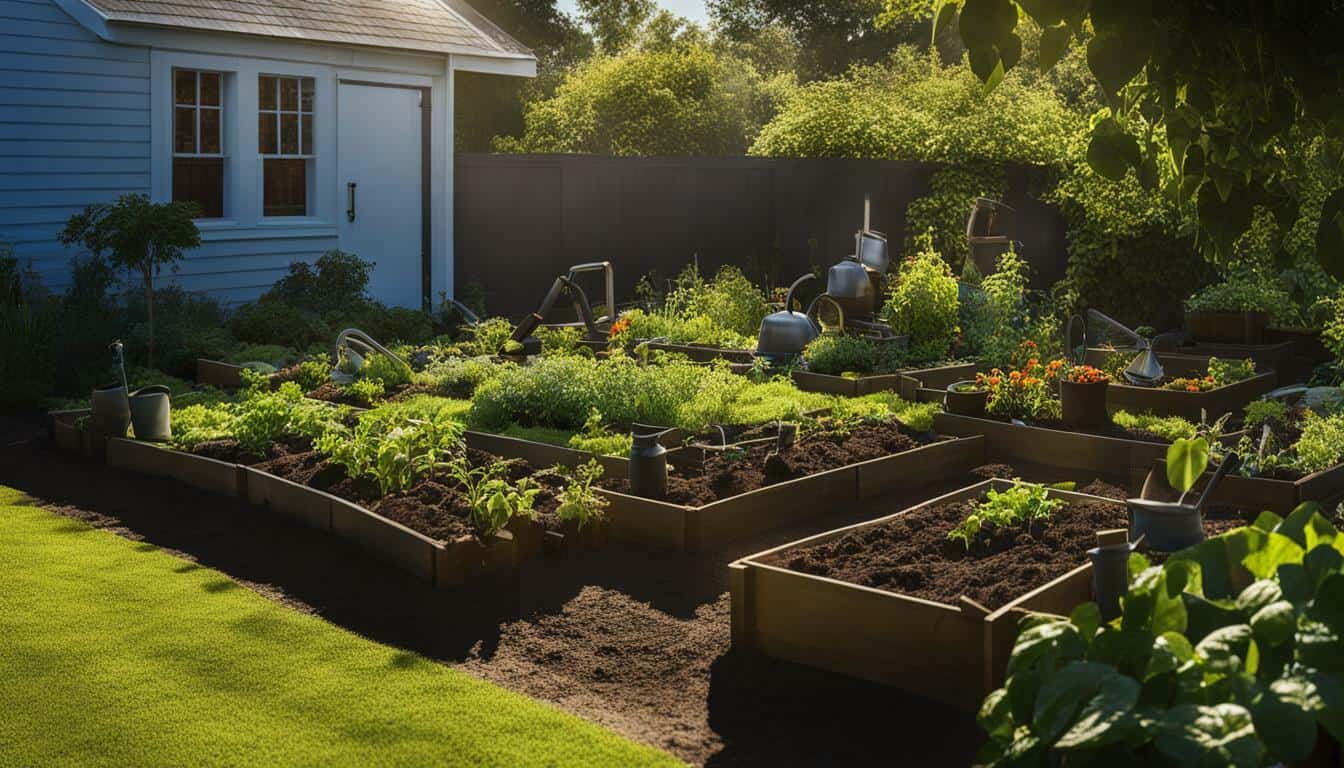



Leave a Reply